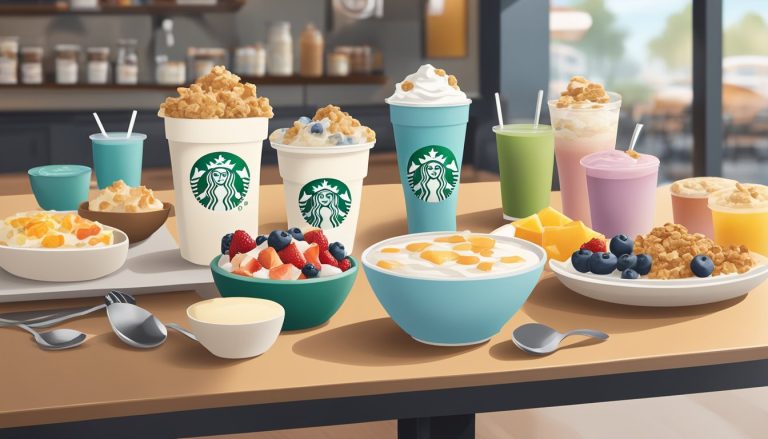Starbucks has mastered the art of creating a sensory experience that extends far beyond just serving coffee. The aroma wafting through their stores plays a crucial role in shaping customers’ perceptions and enhancing their overall enjoyment. The carefully curated scent of freshly brewed coffee is a key component of Starbucks’ strategy to create a comforting and inviting atmosphere for their breakfast offerings.
This emphasis on aroma is not accidental. Starbucks has gone to great lengths to ensure that the smell of coffee remains dominant in their stores. In fact, the company once removed breakfast sandwiches from their menu because the cooking process interfered with the desired coffee scent. This decision demonstrates Starbucks’ commitment to maintaining a consistent and appealing olfactory environment for their customers.
The breakfast experience at Starbucks is designed to be a rewarding ritual that engages all the senses. The aroma of coffee acts as a powerful trigger, evoking feelings of warmth, comfort, and anticipation. It sets the stage for customers to fully immerse themselves in the Starbucks experience, from the moment they step through the door to their final sip of coffee.
Brand and Sensory Influence

Starbucks leverages aroma as a powerful tool to shape its brand identity and forge emotional connections with customers. The strategic use of scent plays a crucial role in creating a distinctive and memorable experience.
Importance of Aroma in Brand Identity
Starbucks has mastered the art of olfactory branding. The moment customers step into a store, they’re enveloped by the rich aroma of freshly ground coffee beans. This signature scent is carefully curated to reinforce Starbucks’ image as a premium coffee purveyor.
The company takes this so seriously that they once removed breakfast sandwiches from the menu when their smell interfered with the coffee aroma. This decision highlights the critical role scent plays in maintaining brand consistency.
Starbucks’ green and yellow store interiors complement the coffee aroma, creating a multisensory brand experience. This cohesive approach enhances brand recognition and sets Starbucks apart in the competitive coffee market.
Building Emotional Connections Through Scent
Aroma is a potent trigger for emotions and memories. Starbucks capitalizes on this by creating a welcoming atmosphere through its signature coffee scent. The familiar smell of coffee grounds and espresso can evoke feelings of comfort, alertness, and anticipation.
This sensory experience helps Starbucks establish an emotional bond with customers. The consistent aroma across locations reinforces the brand’s reliability and quality, fostering brand loyalty.
By engaging multiple senses – smell, sight, sound, taste, and touch – Starbucks crafts a holistic experience. The hiss of espresso machines and the call of baristas complement the coffee aroma, further immersing customers in the Starbucks world.
Understanding Coffee Aroma

Coffee aroma plays a crucial role in the overall sensory experience of enjoying a cup at Starbucks. The complex bouquet of scents contributes significantly to the flavor profile and enhances the coffee tasting process.
Components of Coffee Aroma
Coffee aroma comprises over 800 volatile compounds, each contributing to the unique scent profile. These components include fruity esters, earthy pyrazines, and floral aldehydes. Roast level influences aroma intensity, with darker roasts producing stronger, more pungent scents.
Freshness impacts aroma potency. Whole beans retain aromatic compounds longer than ground coffee. Starbucks prioritizes freshness to ensure customers experience optimal aroma profiles.
Origin affects aroma characteristics. Latin American coffees often exhibit nutty and chocolatey notes. African beans frequently offer fruity and floral scents. Asian varieties tend to have earthy and herbal aromas.
The Science Behind Coffee Scent
The coffee aroma experience begins before the first sip. Volatile compounds released during brewing stimulate olfactory receptors in the nose. These receptors send signals to the brain, triggering memories and emotions associated with specific scents.
Heat plays a vital role in aroma release. As coffee cools, different aromatic compounds become more prominent, altering the perceived flavor profile. This dynamic nature of coffee aroma contributes to a continuously evolving sensory journey.
Brewing methods impact aroma intensity and composition. Espresso extraction produces concentrated aromas, while pour-over methods allow for more subtle scent profiles. Starbucks baristas are trained to optimize brewing techniques to enhance aroma presentation for each coffee variety.
The Breakfast Experience at Starbucks

Starbucks crafts a distinctive breakfast experience by engaging multiple senses and offering a range of morning food options. The company carefully balances its coffee-centric atmosphere with breakfast offerings to create a unique start to customers’ days.
Crafting a Multi-Sensory Experience
Starbucks stores are designed to stimulate the senses, creating an immersive breakfast environment. The aroma of freshly brewed coffee permeates the air, instantly awakening customers. Soft lighting and earth-toned decor contribute to a warm, inviting atmosphere.
Background music sets a relaxed mood, while the sounds of espresso machines and baristas calling out orders add to the vibrant ambiance. The smooth texture of ceramic mugs and the sight of artfully crafted latte foam engage touch and vision.
This sensory-rich environment aims to enhance the overall breakfast experience, making it more than just a quick meal.
The Role of Breakfast Offerings
Starbucks’ breakfast menu complements its coffee selection, providing customers with convenient morning meal options. The company offers a variety of items such as pastries, oatmeal, and egg sandwiches.
However, Starbucks has faced challenges in balancing food offerings with its core coffee identity. In 2008, the company temporarily discontinued warmed breakfast sandwiches due to concerns that their aroma overpowered the coffee scent.
Starbucks emphasizes customization, allowing customers to tailor their breakfast choices. This flexibility caters to diverse preferences and dietary needs, enhancing the overall breakfast experience for a wide range of patrons.
Personalized Aroma Encounters

Starbucks elevates the breakfast experience through customized aromas that engage customers’ senses and create lasting memories. This personalization allows patrons to tailor their coffee journey and savor unique flavor profiles.
The Customer Journey of Coffee Customization
Starbucks empowers customers to craft their ideal coffee experience. Baristas guide patrons through selecting roast levels, brewing methods, and flavor additions. This process heightens anticipation as the chosen beans are ground, releasing their distinctive aroma.
Customers can opt for light, medium, or dark roasts, each offering unique scent profiles. Brewing techniques like pour-over or French press further influence the aroma intensity. Add-ins such as syrups or spices introduce complementary notes.
The visual spectacle of coffee preparation adds to the sensory journey. Watching steam rise from a freshly brewed cup stimulates olfactory senses before the first sip.
Memory and Aroma: Creating Custom Experiences
Aromas have a powerful link to memory formation. Starbucks leverages this connection to create lasting impressions. Each customized coffee order becomes associated with specific scents, enhancing recall of positive experiences.
Regular customers often develop signature orders, forming a personal “aroma profile” that becomes part of their routine. This familiarity breeds comfort and loyalty. Seasonal offerings introduce new scents, creating anticipation and novelty.
Starbucks’ rewards program tracks preferences, allowing baristas to suggest personalized combinations. This tailored approach deepens customer engagement and satisfaction. The aroma of a favorite blend can evoke feelings of warmth and belonging, reinforcing Starbucks’ role in customers’ daily lives.
Starbucks Coffee Selection and Preparation

Starbucks offers a diverse range of coffee varieties and employs innovative brewing techniques to create their signature beverages. Their careful selection process and precise preparation methods contribute to the distinct flavors and aromas that customers have come to expect.
Range of Coffee Varieties and Flavors
Starbucks sources high-quality Arabica beans from various coffee-growing regions worldwide. Their selection includes single-origin coffees and unique blends, each with distinct flavor profiles. Popular options range from bold, intense roasts to lighter, more nuanced varieties.
Starbucks’ core coffees include:
- Pike Place Roast: A smooth, well-rounded blend
- Blonde Roast: Light-bodied with mellow flavors
- Dark Roast: Rich and full-bodied
Seasonal and limited-edition offerings frequently rotate, providing customers with new taste experiences. These may feature regional specialties or experimental flavor combinations.
Innovative Brewing Techniques
Starbucks baristas utilize several brewing methods to extract optimal flavor from their coffee beans. Each technique is tailored to bring out specific characteristics of the coffee.
Common brewing methods include:
- Drip brewing: Standard method for most hot coffee orders
- Espresso: The foundation for many specialty drinks
- Cold brew: Steeped for 20 hours to create a smooth, less acidic flavor
- Pour-over: Allows for precise control over brewing variables
Starbucks also employs advanced equipment like the Clover Brewing System for select locations. This machine uses vacuum-press technology to produce a clean, flavorful cup of coffee.
In-Store Atmosphere and Design

Starbucks crafts a multi-sensory experience through thoughtful store design and atmosphere. The layout, decor, and ambiance work in harmony to highlight coffee aromas and create an inviting space for customers.
Strategic Design for Enhancing Aromas
Starbucks strategically arranges its stores to maximize the impact of coffee scents. Open layouts allow aromas to circulate freely throughout the space. Coffee grinding stations and espresso bars are positioned prominently, ensuring the fragrance of freshly ground beans permeates the air.
Warm lighting and earthy color palettes complement the rich coffee smells. Natural materials like wood and stone are used extensively in furnishings and decor. These elements create a cohesive sensory experience that reinforces Starbucks’ coffee-centric brand identity.
Creating a Social and Comfortable Environment
Starbucks designs its stores to foster social interaction and comfort. A mix of seating options caters to different customer needs:
- Communal tables for group gatherings
- Cozy armchairs for relaxation
- Bar seating for quick visits
Soft background music and warm lighting contribute to a welcoming ambiance. Acoustic treatments help balance noise levels, allowing for conversation without overwhelming the senses.
Art installations and localized decor elements add visual interest and reflect the surrounding community. This attention to detail creates a “third place” atmosphere – a space between home and work where customers feel at ease.
Analyzing Coffee Qualities

Coffee evaluation involves examining key attributes that contribute to its overall sensory profile. These include acidity, body, and the identification of specific flavor notes.
The Role of Acidity and Body in Coffee
Acidity in coffee refers to the bright, tangy quality that adds liveliness to the cup. It can range from crisp and clean to winey or fruity. High-grown coffees often exhibit more pronounced acidity. Body describes the weight and texture of coffee on the palate. It can be light and tea-like or full and syrupy.
Starbucks baristas assess these qualities during coffee tastings. They may use terms like “bright” or “crisp” for acidity, and “heavy” or “smooth” for body. These characteristics help determine how a coffee will pair with food or fit into the breakfast experience.
Identifying Tasting Notes and Flavor Profiles
Coffee flavor profiles are complex, with numerous taste components. Tasters often use a flavor wheel to help identify and describe these notes. Common categories include fruity, nutty, chocolatey, and spicy.
Starbucks trains its staff to recognize these flavors. For example, their Breakfast Blend might have notes of brown sugar and orange zest. Pike Place Roast could exhibit cocoa and toasted nut flavors.
Understanding these profiles helps baristas recommend coffees tailored to customer preferences. It also enhances the overall breakfast experience by allowing for thoughtful pairing with menu items.
The Psychology of Coffee Aroma

Coffee aroma plays a powerful role in shaping customers’ experiences at Starbucks. It creates anticipation, influences perception, and forms emotional connections with the brand.
Aroma as an Element of Anticipation and Reward
The scent of coffee acts as a sensory cue, triggering anticipation in customers before they even take their first sip. This anticipation activates the brain’s reward centers, releasing dopamine and creating positive associations with the Starbucks experience.
Coffee’s aroma also serves as a form of instant gratification. Customers often report feeling more alert and energized simply from smelling freshly brewed coffee. This psychological effect can enhance mood and satisfaction, even before consumption begins.
Starbucks carefully crafts its store environments to maximize the impact of coffee aroma. Strategic ventilation systems and open coffee grinding areas help distribute the scent throughout the space, creating an immersive sensory experience for customers.
The Impact of Aroma on Perception and Choice
Coffee aroma significantly influences how customers perceive the taste and quality of their beverages. Research shows that a pleasing aroma can enhance flavor perception, leading customers to rate their coffee more favorably.
The scent of coffee can also impact decision-making processes. A study conducted in a Starbucks location found that coffee aroma influenced customers’ beverage choices and spending habits. When the coffee scent was more prominent, customers were more likely to choose coffee-based drinks over other options.
Starbucks’ former CEO Howard Schultz recognized the importance of aroma, even removing breakfast sandwiches from the menu when their smell overpowered the coffee scent. This decision highlights the critical role of coffee aroma in maintaining the brand’s sensory identity and customer experience.
Seasonal and Limited Offerings

Starbucks leverages seasonal scents and exclusive flavors to enhance its breakfast experience. These offerings create anticipation and drive customer engagement through limited-time aromas and tastes.
The Role of Seasonal Scents in Consumer Behavior
Seasonal scents play a crucial role in shaping consumer behavior at Starbucks. The iconic Pumpkin Spice Latte exemplifies this strategy, with its warm, spicy aroma signaling the arrival of fall. This scent triggers nostalgia and comfort, encouraging customers to indulge in seasonal offerings.
Starbucks strategically introduces aromas that align with each season. Winter brings peppermint and gingerbread scents, while spring features floral and fruity notes. These changing fragrances create a sensory experience that keeps customers engaged and excited about new breakfast options.
Influence of Limited Editions on Brand Appeal
Limited-edition offerings significantly boost Starbucks’ brand appeal. Exclusive flavors create a sense of urgency and scarcity, prompting customers to visit more frequently. These special items often feature unique presentation elements, such as themed cups or special toppings.
Starbucks’ limited-time breakfast items showcase innovative flavor combinations and ingredients. These offerings allow the brand to experiment with new tastes while maintaining its core menu. The excitement generated by these exclusive products often leads to increased social media buzz and word-of-mouth marketing.
By rotating seasonal and limited-edition items, Starbucks keeps its breakfast menu fresh and exciting. This strategy encourages repeat visits and helps maintain customer interest throughout the year.
Building Customer Satisfaction and Loyalty

Starbucks excels at creating satisfied, loyal customers through its multifaceted approach. The company’s rewards program plays a key role in cultivating repeat business and deepening customer relationships.
Launched in 2009 and revamped in 2019, Starbucks Rewards offers personalized perks to members. Customers earn “stars” with purchases, which can be redeemed for free drinks, food items, and merchandise.
The program’s digital integration enhances convenience. Mobile ordering allows customers to skip lines and customize drinks easily. This technological edge caters to modern consumers’ desire for efficiency.
Personalization extends beyond rewards. Baristas often remember regulars’ preferred orders, fostering a sense of belonging. This individual attention contributes to the “third place” atmosphere Starbucks aims to create.
Quality and consistency also drive satisfaction. Customers trust they’ll receive the same high standard whether visiting a store in New York or Tokyo. This reliability builds confidence and encourages repeat visits.
Seasonal offerings and limited-time promotions keep the menu fresh and exciting. These temporary items create a sense of urgency and exclusivity, encouraging customers to visit more frequently.
By combining these elements – rewards, personalization, quality, and innovation – Starbucks creates a comprehensive strategy for building lasting customer relationships. This approach has proven effective in maintaining the brand’s position as a leader in the competitive coffee market.




